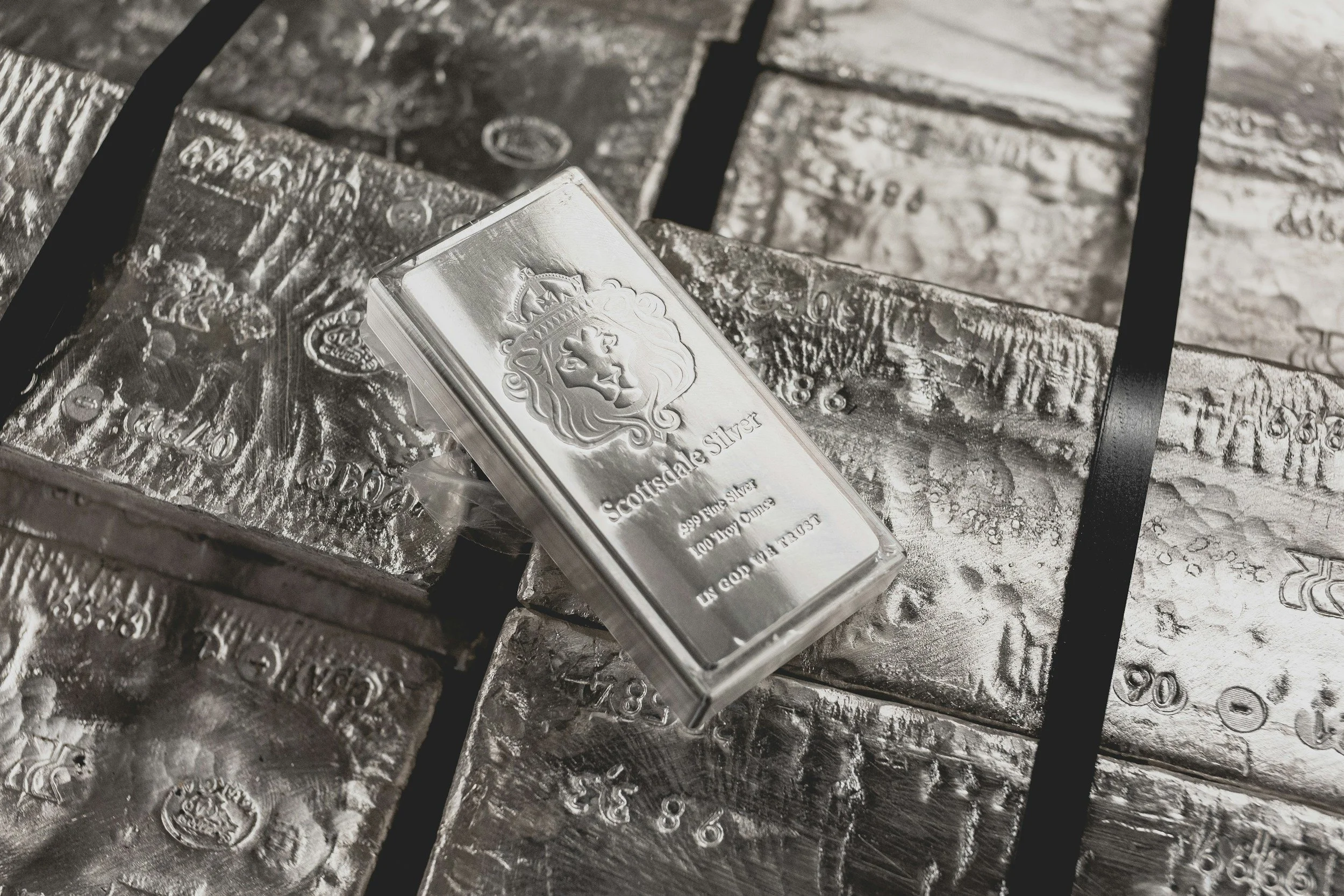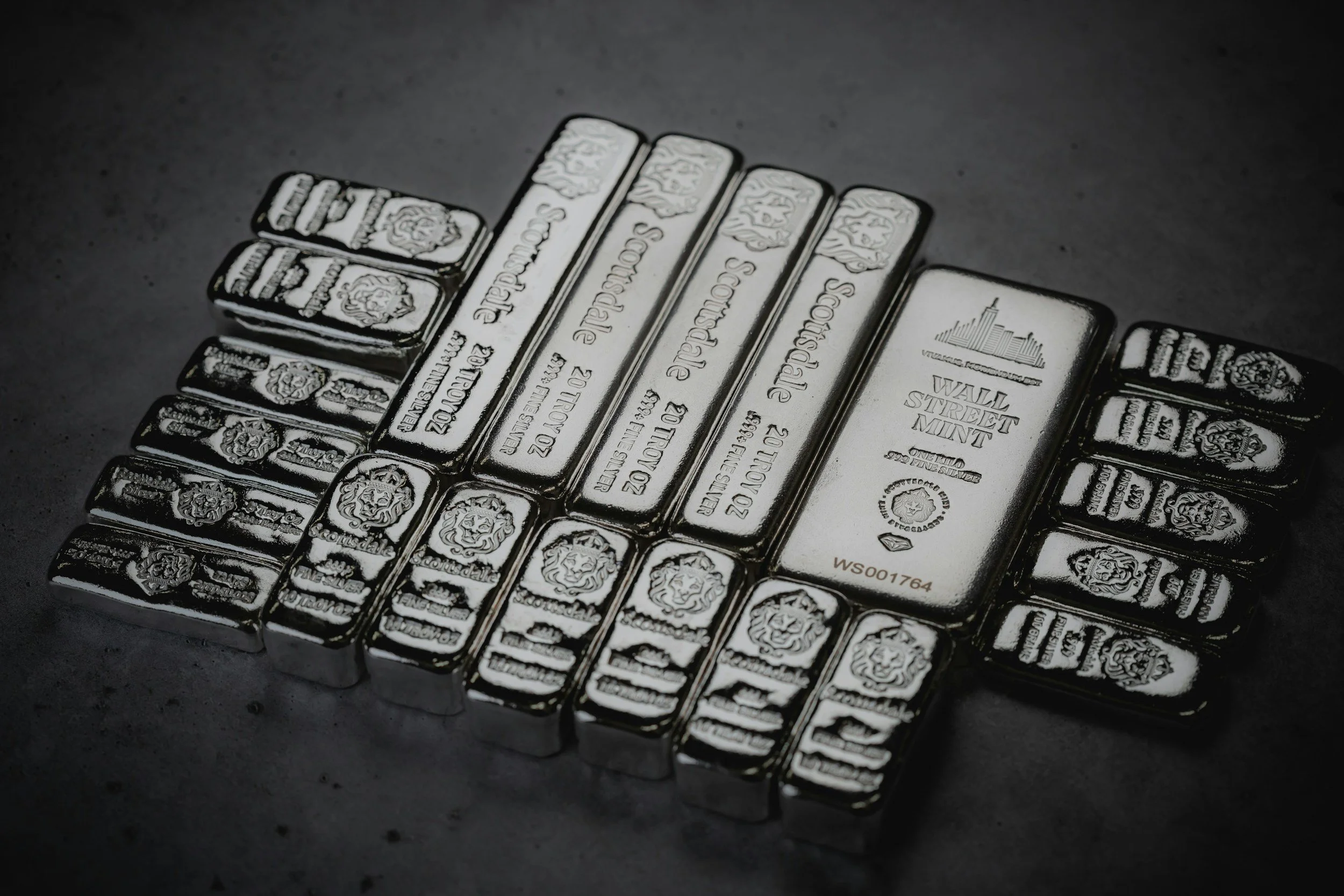SILVER // A Guide to indicators and investment
After years in gold’s shadow, silver is having its moment. In recent months, demand for the metal has accelerated across every channel, from physical bars and coins to ETFs and industrial applications, driving prices to multi-year highs and sparking whispers of shortage. What began as a technical commodity story has evolved into a mirror of our age: a world caught between transition and uncertainty, seeking both growth and security.
For centuries, silver’s identity was bound to its relationship with gold as the humbler sibling, less glamorous but equally elemental. Yet today, its story is driven less by jewellery or investment speculation and more by innovation.
Silver is a critical input for solar panels, electric vehicles, 5G networks, and medical technologies. As governments and corporations race to decarbonise and electrify, the demand for silver’s unique conductive and antimicrobial properties has skyrocketed.
The result? Industrial consumption now accounts for more than half of total silver demand and a share that continues to grow even as mine supply stagnates. According to the Silver Institute, the market faces one of the deepest structural deficits in decades, with demand outstripping supply for the fourth consecutive year.
Scarcity, Sentiment, and the Search for Tangibility
There’s another layer to this story which is both psychological, and financial.
As central banks navigate post-inflation fragility, bond yields fluctuate, and geopolitical tensions escalate, investors are quietly reallocating toward tangible assets. Silver sits at a unique crossroads: a hard asset with industrial utility. It offers the narrative security of gold with the growth exposure of technology.
ETF inflows and physical silver purchases have risen sharply as investors seek protection from monetary debasement, digital instability, and currency risk. Yet the irony is that silver itself is becoming increasingly difficult to find. Inventories at major exchanges, including the London Bullion Market Association, are at record lows. Some ETFs have even restricted new subscriptions due to physical shortages which is an echo of 2021’s “silver squeeze,” but with deeper fundamentals.
Why Supply Can’t Catch Up
Silver’s scarcity isn’t just about demand it’s also about how it’s produced. Roughly 70% of silver is mined as a by-product of other metals like zinc, copper, or lead. This means that even as silver prices rise, production can’t simply ramp up unless those other metals do too. Recycling offers some buffer, but it remains insufficient to close the gap.
In economic terms, this is a low-elasticity market: price incentives don’t easily translate to increased supply. The outcome? Amplified volatility and growing premiums for physical delivery.
A Market Reflecting Its Times
The surge in silver tells a broader story. We are living through a decade defined by paradox:
A technological revolution that demands minerals.
A financial system searching for trust and tangibility.
A climate imperative reshaping entire supply chains.
Silver embodies that tension. It’s industrial yet ancient, functional yet symbolic. Its ascent reveals the contours of an economy moving from intangible growth to tangible value or from digital assets to elemental ones.
What Comes Next
If the green transition continues at pace, industrial demand will anchor silver’s floor. If central banks pivot toward easing, investment demand could lift the ceiling. Add in declining inventories and limited new supply, and the setup becomes clear: volatility with a bias to scarcity.
As history reminds us, silver’s charm lies in its duality as both a barometer of confidence and a hedge against its collapse. Its recent rally is less about greed than about caution: a quiet repositioning by those who see that the future, from solar grids to balance sheets, will be built not on paper, but on materials that last.
Checklist: Key Silver Market Indicators to Watch
1. Spot Price & Futures Curve
Watch daily spot prices on the London Bullion Market (LBMA) and COMEX.
A backwardation curve (spot higher than futures) often signals immediate physical tightness.
2. ETF & ETP Inflows
Rising inflows into silver-backed exchange-traded products (ETFs/ETPs) suggest growing investor demand.
Key funds: iShares Silver Trust (SLV), Sprott Physical Silver Trust (PSLV), WisdomTree Silver.
3. Physical Premiums
Compare retail premiums for coins/bars versus the LBMA spot price.
Higher premiums = physical scarcity or delivery constraints.
4. Industrial Demand Data
Track demand from solar PV, electronics, and EV sectors which are published quarterly by the Silver Institute.
Watch for substitution trends: “silver thrifting” (using less silver per product) or material alternatives.
5. Mining Supply & Recycling Rates
Note total mine output and recycled silver statistics from World Silver Survey.
Watch large mining jurisdictions (Mexico, Peru, China). Production lags or political disruptions tighten supply.
6. Inventory Levels
Monitor LBMA and COMEX vault data. Declining registered inventories can precede price spikes.
7. Monetary Policy Signals
Silver is highly sensitive to real interest rates and US dollar strength.
Lower rates or a weaker dollar typically lift silver.
8. Geopolitical & Trade Dynamics
Sanctions, tariffs, or logistics disruptions can restrict silver flow.
China and India dominate silver consumption; policy changes in either market ripple globally.
9. Energy Transition Indicators
The global rollout of renewables is directly linked to industrial silver use.
Watch clean energy investment data, EV adoption rates, and government subsidy shifts.
10. Investor Sentiment & Volatility Indexes
Track CFTC positioning reports for speculative futures positions.
Spikes in speculative shorts or longs often precede sharp reversals.
Glossary of Silver Market Terms
1. Spot Price
The current market price for immediate delivery of silver, quoted in USD per ounce.
2. Futures Contract
A standardised agreement to buy or sell silver at a set price at a future date and traded on exchanges like COMEX.
3. Backwardation / Contango
When spot prices exceed futures prices, it’s backwardation (implies tight supply).
When futures prices are higher than spot, it’s contango (ample supply).
4. ETF / ETP
Exchange-Traded Fund or Product which are investment vehicles that track silver prices. Some hold physical silver, others synthetic exposure through derivatives.
5. Physical Premium
The difference between the market spot price and the actual retail cost of physical silver (coins, bars). Reflects logistics, scarcity, and dealer demand.
6. Industrial Demand
Silver used in manufacturing sectors like solar, electronics, medical, and EVs are now over 50% of total demand.
7. Structural Deficit
When annual demand (industrial + investment) exceeds mine supply and recycling combined. Persistent deficits push prices up.
8. Inventory (LBMA / COMEX)
The amount of registered silver held in certified vaults for delivery. Shrinking inventory often signals physical tightness.
9. By-product Mining
Most silver is mined alongside other metals (copper, lead, zinc). Supply therefore depends on broader mining economics.
10. Safe-Haven Asset
An investment perceived to hold value during financial uncertainty. Silver shares this status with gold, but with more industrial leverage.
11. Real Interest Rates
Nominal interest rates minus inflation. When real rates are low or negative, non-yielding assets like silver become more attractive.
12. Dollar Index (DXY)
A measure of the US dollar’s strength against major currencies. Silver usually moves inversely to the dollar.
13. CFTC Positioning Data
Weekly reports from the US Commodity Futures Trading Commission showing speculative long/short positions which is a window into market sentiment.
14. Thrifting
Reducing the amount of silver used in products without affecting performance. A key risk to demand if prices spike.
15. Recyclable Supply
Silver recovered from industrial scrap or outdated electronics. The main flexible component of supply during high-price environments.


